In an earlier post I showed a drawing of my community garden, together with some ideas of what I would grow and where. Here’s a little bit of an update.
The apple trees are in bloom:

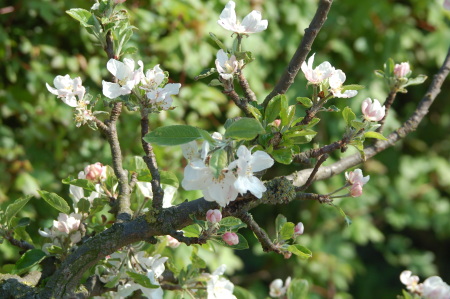
The pears have already begun setting fruit, and while late frosts killed most of the plum blossoms, a few have managed to set fruit as well.
I just transplanted corn plants started indoors into bed #4:
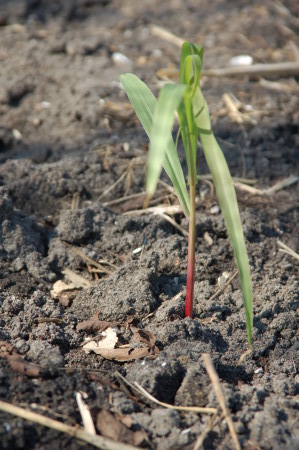
Here is a yacón plant in bed #3, next to weed suppressing plastic:
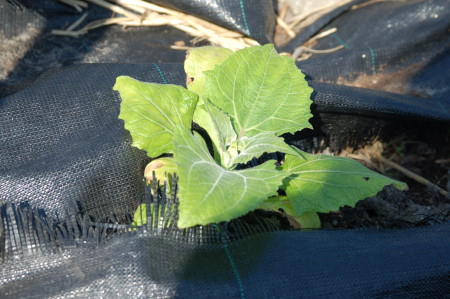
I started the Ulluco indoors, and recently transplanted it to bed #3. It’s an amazingly fragile plant, and it’s still suffering a bit from the shock of being transplanted. To anyone else considering starting it indoors, be sure to start with a large pot as it gets root bound very quickly.
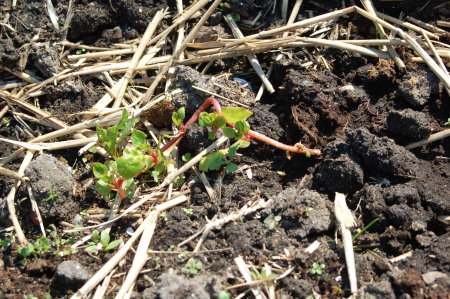
I planted a few Ulluco tubers early, with my potatoes, and that seems to have been a mistake. In spite of a layer of straw to protect against some late frosts, they don’t seem to have survived. Together with these transplants, I have also planted my last few tubers, so we’ll see how they do.
My potatoes are starting to poke through the ground:
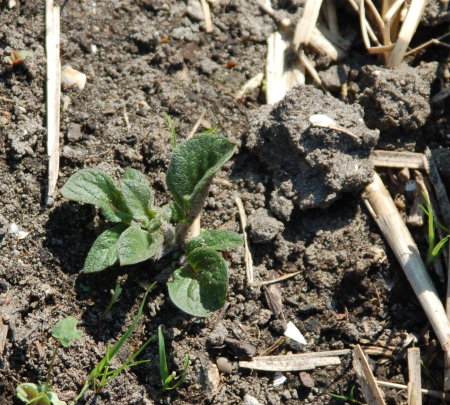
The garlic in beds #1 and #2 is getting huge! I’ve already started harvesting spring garlic, yum!
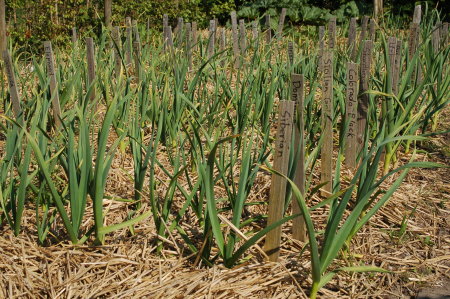
I’ve also been harvesting rhubarb, left behind be the previous gardener. It’s amazing how good home grown rhubarb tastes compared with what you buy in the store. I wonder what they do to store bought rhubarb that makes it taste so bad!
Still to be planted out are some cucumbers and squash to go with the corn in bed #4 and some white Alpine Strawberries to go in the back of bed #3.
The tomatoes are doing well in the greenhouse, but there are too many weeds to take a picture right now. I have taken out a part of the patio and the red currant bed, and have been building some raised beds in their place. I’ll take some pictures of this when it’s a little more finished. In these beds, I’ve already planted celeriac (celery root), Crosne (I’ll post more about this later), some peppers and the asparagus plants. I plant to put swiss chard, beets and beans in other beds in this spot.
I’ve planted some tomatillos next to the garlic in bed #1.
My Belgian friend Lieven also gave me a number of soft fruit plants, and these have gone in on the back side of bed #1 as well as the empty space between the red currant and cold frame in the garden sketch.
I recently planted tubers or seeds of ground nuts, Oca, Mashua and Salsify in bed #3. The Jerusalem Artichoke I planted in the fall in the back of bed #3 has also started coming up.
I planted some peas in the back of bed #4, but they are not doing well. I’m still trying to understand what went wrong there, and perhaps I’ll post some more about that later.
I still have a number of seeds to plant, including those given to me by others I need to say more about. I also have more to say about where a number of the plants I’ve already mentioned came from. I’ll do this in other posts.
The weeds are driving me crazy! In the last few years I was growing on heavy clay, and the size of the garden meant I mostly gave up on the weeds where they couldn’t be mulched. This year I am trying to keep them much more under control, but it’s a lot of work.
The previous gardener let the weeds get out of hand, and many have become very established and there are a lot of seeds in the ground. He also build an extensive network of paths with paving stones, and this has generated a huge problem with the weeds and used a lot of space better made available for plants. I have been slowly taking up these stones, and using them to build the raised beds. I have to do this a little at a time because they are so heavy, and as a result the garden is in a bit of a state of disarray right now.


Patrick,
each year I’m growing ullucus in tubs, I never got the impression they get rootbound. They don’t like this dry weather we’re having for the moment, that’s one of the reasons why I grow them in tubs, I can move them into a shady place, an other advantage is frost protection in autumn, tubs are easily moved into the greenhouse.Did I send you this grow-out manual for ullucus?
Your garlic looks great, and what’s ground nut: apios americana or hog peanut or..?
Oh Patrick, it looks beautiful. I’m sure the weeds are enough to make you want to pull your fingernails out, but just think, in a few years, after you’ve made this place your own, the weeds won’t be near as much of a problem. I can’t wait to read more about your seeds and their sources.
What are you doing with your green garlic? Isn’t it delicious?
Frank:
I started a few very small ulluco tubers in pots I would normally start a tomato plant, which were much too small. Then I potted up to something about twice as big, and that still wasn’t enough. I can imagine if you start out with a big tub, it wouldn’t become root bound so easily.
A number of us with blogs have some ulluco from Real Seeds, and it came with the message it was only an experimental plant and it wasn’t known how to grow it in the UK climate. They had a few suggestions about putting it in a sunny place before planting out to prevent it from sprouting too much, and hilling up like a potato, but otherwise there weren’t really any instructions. I asked Lieven about it, and he said simply it didn’t grow for him when he tried.
I started it indoors, because I read on the Internet someone suggested it, but otherwise I couldn’t find much information on the Internet about it.
So, yes, if you have growing instructions or any suggestions in general about the ulluco, I would love to get these from you!
And yes, I think the ground nut I have is apios americana, at least it looks like the pictures on the Internet. Lieven gave it to me and didn’t say much about it except it was nitrogen fixing, grew easily and to harvest it you could just follow the root because the tubers were tied together in a long line by the root and it was strong enough not to break easily. I see on the Internet it is identified as an ‘edible weed’.
Hi Christina:
It’s funny how everyone has a different name for green garlic. I usually call it spring garlic, Kenny of Veggie Gardening Tips usually calls it baby garlic.
I saw on Future House, Kelly made a great looking pasta sauce with it.
We eat garlic of some kind in almost every meal these days, all year round, and we use spring garlic almost like normal garlic but try not to cook it as much because the flavor can be a little delicate when cooked. It’s great in salad dressing, baked pasta and stir-fries. We also eat the chopped green top of the garlic plant in similar ways, but the texture is a little tough so it has to be chopped fine.
We still have some normal garlic left over from last year, but that’s running out. We use garlic greens, spring garlic and garlic harvested ‘fresh’ to fill the summer gap when no other garlic is available.
When we plant garlic, we always use the biggest cloves from the biggest bulbs for our main crop. All the leftover cloves get planted in a separate place for use as spring garlic.
Can you tell we like garlic!
Yes, if Lieven gave it to you , it must be the apios (he got it originally from me). I do start the ullucus in 10×10 cms pots, no problem with it, as long as they don’t dry out completely.
Here we go with some notes of my experiences over the years:
Ulluco (ullucus tuberosus) is a perennial plant, but grown as an annual in our temperate regions. The plants are almost exclusively propagated by tubers, a bit comparable to potato growing. Tubers are started off in small pots in the greenhouse or on a windowsill, make sure they have plenty of light and water. Plant the tubers some 2-5 cm deep, depending on tuber size (bigger tubers can be deeper planted).The best time to start them is end of March , until even end of April. They are damaged by frosts, even though some reports mention they stand up to -5 degrees Celsius. This is not my experience, so take care ! The plants prefer a moderate heat, they don’t stand really warm (and dry) conditions. 15-25 ° seems to suit them best! Outside planting can be done from mid-May, whenever the risk of frosts is gone. They don’t grow big, space them 20-30 cms. in good garden soil. Height is at the most 30 cms., the plants can be earthed up a little bit, the way potatoes are earthed up (don’t exaggerate though).
Ulluco will grow steadily throughout the summer, tubers only begin forming from the end of September, when the days are shorter than 12 hours. From then on, you will probably spot tiny stems forming in the axils of the leaves. These stems will be heading directly to the soil. When they reach and penetrate the soil, tubers will be formed at the end of the stems. Be careful, the stems and attachment points are very brittle. Sometimes I earth up these newly forming tubers, this is not necessary, but if the tubers are exposed to light, they will turn green (some varieties are green anyway). This is purely esthetical, I have never read a report that these green tubers contain toxic elements (the Ullucus is not a member of the more familiar solanaceae family, to which potatoes belong). Try to keep the plants frost-free, tubers only reach their full size in November or even December.
Some alternative methods can be used, I prefer growing them in big tubs, and moving them into the greenhouse whenever the temperatures go down. They are really comfortable in tubs, though the harvest will likely be a bit smaller. Water them regularly, as pots can dry out quickly in warm weather. Another advantage of this method is whenever the summer is really hot, you can easily move them to a more shady spot.
Don’t expect really a really big harvest in our climate, tubers are at the most 8cms long, you will get many small tubers and a few larger ones. A 1 kgs harvest from one plant is really very very good; if you have such a result, try and re-grow the best looking tubers from such a big-crop plant, that way you will be selecting on on these bigger –crop qualities.
Ullucus is prepared the way potatoes are prepared: they can be boiled, baked, mashed,…
Patrick,
your garlic bed looks very impressive! I remember quite a long list of them you plant 🙂
It’s a busy time of year in the veggie garden especially now that the weather is so good.
That’s a lot of garlic that you planted, phew I can smell them from here.
I harvested some rhubarb recently too and it was scrumptious, as you say much much better than the stuff you buy in the shops but that goes for practically everything you grow yourself. Have you tasted any shop bought radishes lately? Radishes grown yourself have so much more taste, the shop bought ones taste of hardly anything at all.
Hi Ewa and YE,
Thanks for the comments!
It’s nearly 100 different kinds of garlic, about 15 plants each, for a total of about 1500 plants. There is a really big difference in the taste and appearance in most of the different kinds.
Last year I had 800 plants, and they are all gone! Very few of them rotted or otherwise had to be thrown away. It seems like I can never have too many garlic plants.
When I dig in the ground around the garlic the smell comes out very strong! It makes the garden smell like a salami factory.
Just like other things, home grown garlic tastes very nice when compared to what you buy in the store.
YE, I agree with you on the radishes. What you get in the store don’t usually taste very nice, but home grown ones can be a real treat.